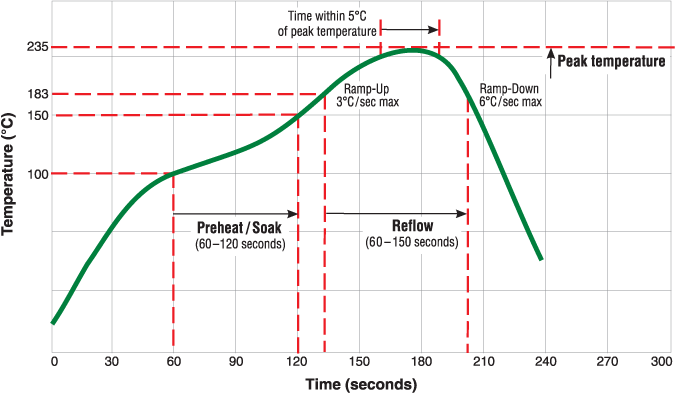

Water soluble fluxes can leave weak organic acid (WOA) residues that must be thoroughly removed from all pc board components. All fine wire components, like many inductors, should be considered potentially susceptible.
Thorough rinsing and drying is required to remove water-soluble flux residue from all pc board areas, especially irregular component surfaces where contaminants can easily collect. If not removed completely, water-soluble flux residue can cause immediate or latent corrosion.
Coilcraft strongly recommends consulting both the solder and water-soluble flux manufacturer for complete application information.
 Download Application Note – Soldering surface mount components
Download Application Note – Soldering surface mount components| RoHS | Units | |
| Preheat / Soak Temperature | 150 – 200 | °C |
| Preheat / Soak Duration | 60 – 120 | seconds |
| Ramp-up Rate | 3 | °C / second |
| Typ. Reflow Temperature | 217 | °C |
| Peak Temperature | 255 – 260 | °C |
| Time Within 5 °C of Peak | 30 | seconds |
| Time Above Reflow Temperature | 60 – 150 | seconds |
| Ramp-down Rate | 6 | °C / second |

.png) Download Application Note – Soldering surface mount components
Download Application Note – Soldering surface mount components| RoHS | Units | |
| Preheat / Soak Temperature | 100 – 150 | °C |
| Preheat / Soak Duration | 60 – 120 | seconds |
| Ramp-up Rate | 3 | °C / second |
| Typ. Reflow Temperature | 183 | °C |
| Peak Temperature | 235 | °C |
| Time Within 5 °C of Peak | 20 | seconds |
| Time Above Reflow Temperature | 60 – 150 | seconds |
| Ramp-down Rate | 6 | °C / second |

All our RoHS-compliant parts are backward compatible with tin-lead soldering processes.
For all soldering methods, the optimal soldering profile for a circuit board assembly is dependent on the solder material, solder amount, flux, temperature limit of each soldered component, heat transfer characteristics of the circuit board and component materials, and the layout of all components. The temperature vs. time limitation of the least robust component of the circuit board assembly ultimately dictates the optimal temperature profile. For this reason, Coilcraft does not provide soldering profiles for our components.
CAUTION: All of Coilcraft’s through-hole components are designed to be wave soldered and it is not recommended to use a reflow soldering procedure. The higher temperatures of reflow soldering may damage these components.
Coilcraft’s through-hole components can be successfully wave soldered as long as care is taken throughout the process. For many of the components, it is essential to minimize the circuit board temperature and the time spent over the solder nozzle. In order to achieve a quality bond without damaging the components, Coilcraft recommends preheating the board for up to three minutes and limiting the time the board spends over the solder nozzle to three seconds.
For further reference: